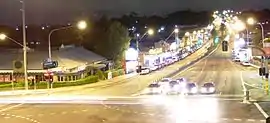A3 (Sydney)
The A3 is a major metropolitan arterial route in Sydney. It was formerly designated as Metroad 3. The A3 runs from its intersection with the A8 at Mona Vale at the north end, to the southerly of its two intersections with A1, the Princes Highway, at Blakehurst the south end. The highest speed limit on the (A3) is 90 km/h (56 mph) on Mona Vale Road.
A3 | |
|---|---|
 | |
A3 (King Georges Rd) looking south at Roselands NSW | |
| General information | |
| Type | Highway |
| Length | 51.3 km (32 mi) |
| Opened | 1950's |
| History | Superseded Metroad 3 in 2013 A3 Currently |
| Route number(s) |
|
| Former route number |
|
| Major junctions | |
| North end | Mona Vale |
Forest Way
| |
| South end | Blakehurst |
| Location(s) | |
| Region | Sydney |
| LGA(s) | |
| Major suburbs | Mona Vale, Terrey Hills, St. Ives, Pymble, West Pymble, Macquarie Park, North Ryde, Ryde, Rhodes, Liberty Grove, Sydney Olympic Park, Homebush West, Chullora, Wiley Park, Beverly Hills, Hurstville, Blakehurst |
| Highway system | |
It is a major connector between most of the major radial routes emanating from central Sydney, and a major link between the northern and southern parts of the Sydney tolled orbital freeway. It is the most direct, although not necessarily the quickest, route across Sydney between the South Coast and the North Coast.
Most of the route has been progressively upgraded to three lanes in each direction (although the kerbside lanes are often blocked by parking). Sections which are only two lanes in each direction remain, between Beverley Hills and South Hurstville, along Homebush Bay Drive, and between St Ives and Terry Hills. Between Mona Vale and Terry Hills, most of the eastern section of Mona Vale Road is only 1 lane in each direction. Much of the route becomes very congested in peak hour.
The name "A3" is the route allocation for the route as a whole, not a road name. The A3 route runs along a whole series of differently named roads. From north to south they are:
- Mona Vale Road
- Ryde Road
- Lane Cove Road
- Devlin Street
- Church Street
- Concord Road
- Homebush Bay Drive
- Centenary Drive
- Roberts Road
- Wiley Avenue
- King Georges Road

History
What is now called A3 was initially designated to become a major north–south metropolitan arterial route in 1964, when the route incorporating several existing local arterial roads was designated as 'Ring Road 3'. After 1964, upgrading projects were commenced, with the construction of new De Burghs Bridges over the Lane Cove River between Pymble and Ryde (1967). It was subsequently re-designated 'State Route 33' in 1974. A grade-separated crossing was constructed at Epping Road at North Ryde (1978).[2]
Prior to 1983, around the Strathfield area the A3 route passed through the Strathfield town centre, proceeding along (north to south) Concord Road, the Boulevarde, Coronation Parade and Punchbowl Road, to join King Georges Road. The part of this route that passes through Strathfield town centre was very congested also problematical to widen. A major deviation of this part of the route was built between 1983 an 1998, relocating the arterial route to the west between Rhodes and Wiley Park, to bypass the Strathfield bottleneck and improve access to the Olympic Precinct at Homebush Bay. The deviated route includes Homebush Bay Drive, Centenary Drive, and an upgraded Roberts Road though Chullora and Greenacre, connecting to King Georges Road near Wiley Park. The road upgrades, new bridges and connections for this deviation were completed in stages between 1983 and 1998.[2] The original route was subsequently given the route allocation State Route 27 which was decommissioned in 2004.[3]
Also during this period, Ryde Bridge over the Parramatta River between Ryde and Rhodes was duplicated (1988), grade-separate crossings were constructed at the Pacific Highway at Pymble (grade separation completed in 1989).
The whole route was re-designated 'Metroad 3' after April 1993.[2] It is the only one of Sydney's 'Metroad' routes that has not changed alignment since the Metroad system was adopted in 1993. In August 2013, as part of the alphanumeric route scheme, Metroad 3 was decommissioned and was designated A3.
As a major access route to Sydney Olympic Park, a grade-separated crossing was constructed at the M4 Western Motorway and Parramatta Road, at Flemington (1992) and the intersection with Australia Avenue and Underwood Road at Homebush (1998). Grade-separated crossings were also constructed at M2 Hills Motorway at Macquarie Park (1997), at Victoria Road at Top Ryde (1998),[2] the Hume Highway at Chullora (1998), and the M5 South Western Motorway at Beverly Hills (2001).
Many projects have been undertaken over the decades to widen most of the route in stages to three lanes each way, although no proper freeway sections have ever been constructed.
See also
![]() Australian Roads portal
Australian Roads portal
References
- Sydney Ring Road, Ozroads. Retrieved 16 June 2013.
- "Metroad 3 History". Ozroads. Retrieved 16 June 2013.
- "State Route 27". Ozroads. Retrieved 2 August 2013.